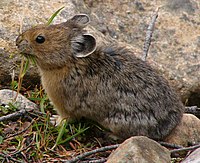
Photo from wikipedia
Abstract Natal dispersal—the movement from birth site to first breeding site—determines demographic and population genetic dynamics and has important consequences for ecological and evolutionary processes. Recent work suggested that one… Click to show full abstract
Abstract Natal dispersal—the movement from birth site to first breeding site—determines demographic and population genetic dynamics and has important consequences for ecological and evolutionary processes. Recent work suggested that one of the main factors determining natal dispersal distances is the cost of locomotion. We evaluated this hypothesis using band recovery data to estimate natal dispersal distances for 50 North American bird species. We then analyzed the relationships between dispersal distances and a suite of morphological and ecological predictors, including proxies for the cost of locomotion (flight efficiency), using phylogenetic regression models. We found that flight efficiency, population size, and habitat influence natal dispersal distances. We discuss how the effects of population size and habitat can also be related to mobility and locomotion. Our findings are consistent with a predominant effect of adaptations for mobility on dispersal distances.
Journal Title: Ecology and Evolution
Year Published: 2023
Link to full text (if available)
Share on Social Media: Sign Up to like & get
recommendations!